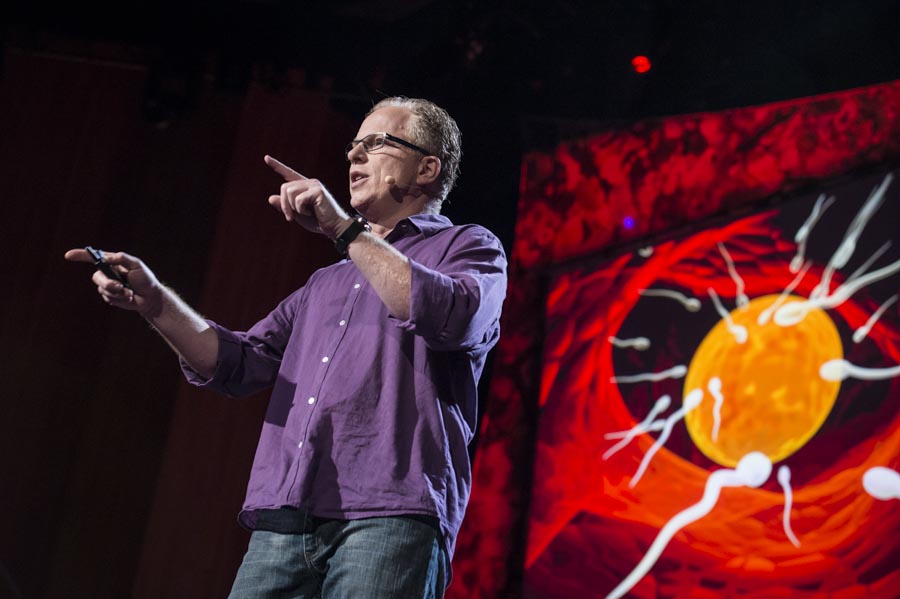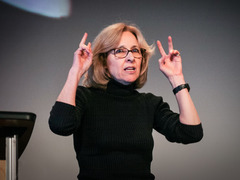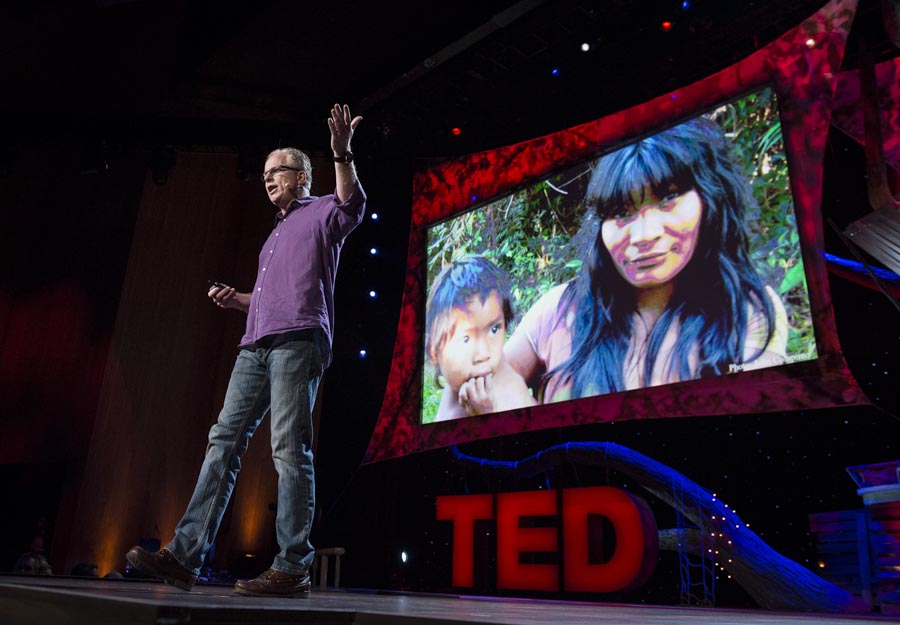
Photos: James Duncan Davidson
 Helen Fisher: Why we love, why we cheat
Helen Fisher: Why we love, why we cheat
Humans have sex like apes
Christopher Ryan begins his talk with a strong reminder, “We didn’t descend from apes. We are apes.” A special kind, but we are one. We’re closer to chimps and bonobos than they are to any other primate. But he wants to know, “What kind of ape are we? Particularly in terms of our sexuality.”
That’s a subject he’s been investigating as the co-author, with Cacilda Jethá, of Sex at Dawn. He says that there has been a standard narrative — that men and women are locked in an eternal struggle. That throughout history men have “leased” women’s sexuality in return for security.
This narrative is mistaken. It turns out that in many societies those things were shared in what he calls a “fierce egalitarianism.” Ryan makes it clear that he is not saying they were noble savages. But he notes that that social structure did exist, and is further saying this extends to sexuality. That “human sexuality has essentially evolved, until agriculture, as a way of maintaining and establishing the complex social networks that our ancestors were very good at.” He is also quick to note he is saying ancestors were promiscuous, but is not saying they were having sex with strangers, because, “There were no strangers.”
This is also not to criticize monogamy. “To argue that our ancestors were sexual omnivores,” says Ryan, “is no more a criticism of monogamy than arguing that our ancestors were dietary omnivores is a criticism of vegetarianism.”
 Mary Roach: 10 things you didn't know about orgasm
Mary Roach: 10 things you didn't know about orgasm
Evidence from anatomy and anthropology
Where did our misconceptions about sex come from? Well, Darwin, as it turns out, was a world-class Victorian prude. He was fascinated by the colorful genital swelling in bonobos, but what he didn’t know is that female chimps have sex 1-4 times an hour with up to a dozen partners. Furthermore, Ryan notes that female chimps are sexually available for 40% of their menstrual cycles, but bonobos for 90% — almost as much as humans, who are capable of engaging in sex at any point in their cycle. That is a trait that is vanishingly rare among mammals.
For Ryan, a key question to understanding the origin of human sexuality is, “Are human beings a species that evolved in the context of sperm competition?” Are they competing against each other or with the sperm of other men as well? It doesn’t seem to be the case. For example, the average human has sex about a thousand times per birth. “If that seems high to you,” laughs Ryan, “don’t worry, it seems low to other people in the audience.” A more typical number among apes is to have sex about a dozen times per birth. Additionally, Ryan notes, humans and bonobos are among the only animals that have sex face to face. They also have external testicles. Says Ryan, “External testicles are like having an extra fridge in the garage for beer. If you’re the kind of guy that has a beer fridge, you expect a party to happen at any moment.”
The evidence that the standard model isn’t correct extends beyond anatomy to anthropology. When one looks, they find all kinds of societies which have sexual practices that should not exist if the standard model is correct. In one culture, they found no shame about sex, and women with many lovers — some with well over 100. Who takes care of the children of those unions? The responsibility falls to the mother, her sisters and brothers. The biological father has no role.
 In the Amazon basin, there are a few societies where a child can have many fathers. Those cultures believe that a fetus is made of accumulated semen. A woman who wants a child who is smart, funny and strong will have sex with one man who is smart, one who is funny and one who is strong. When the child is born, each of these men will come forward. Paternity is a team endeavor.
In the Amazon basin, there are a few societies where a child can have many fathers. Those cultures believe that a fetus is made of accumulated semen. A woman who wants a child who is smart, funny and strong will have sex with one man who is smart, one who is funny and one who is strong. When the child is born, each of these men will come forward. Paternity is a team endeavor.
 Esther Perel: The secret to desire in a long-term relationship
Esther Perel: The secret to desire in a long-term relationship
What does this mean?
Why is this important? Ryan is worried: “Our evolved nature is in conflict with many aspects of the modern world…. There is a conflict between what we feel and what we’re told we should feel.”
He hopes that thinking about the origin of sex will make us become more tolerant of alternative arrangements than the Victorian models. And most importantly, to “finally put to rest the notion that men have an innate right or instinctive need to control women’s sexual behavior.” He says our real fight is not between the genders, but with “an outdated Victorian notion of morality, that conflates desire with property rights.”
In other words: Forget about “men are from Mars and women are from Venus. Men are from Africa, and women are from Africa.”
Comments (10)
Pingback: Why “The One” Doesn’t Exist – emlovz
Pingback: Why “The One” Doesn’t Exist | Exotic Meetup Dating | No Longer A Dream
Pingback: ازدواج، کلوپ جنسی دو نفره – مرد روز
Pingback: درمان میگرن - ۱۴ مورد از راه های درمان خانگی میگرن • نوآورد
Pingback: Der größte Dieb und warum wir ihm nackt begegnen sollten | Endlich ausgewogen!
Pingback: The best of the web | My Favorite 31 Talks From TED 2013
Pingback: آیا از تسل میمونیم؟ | Reza Nazmi رضا نظمی